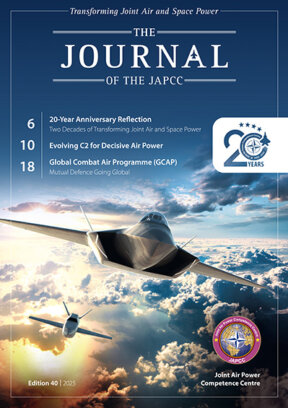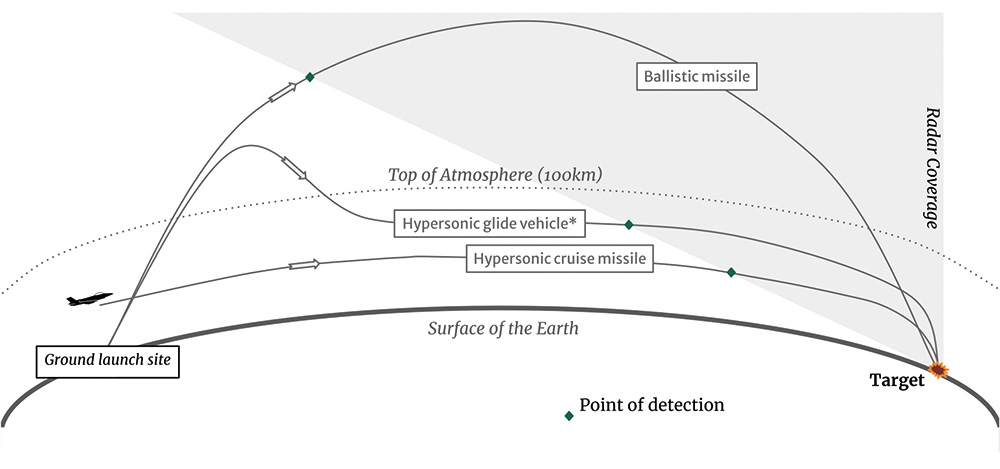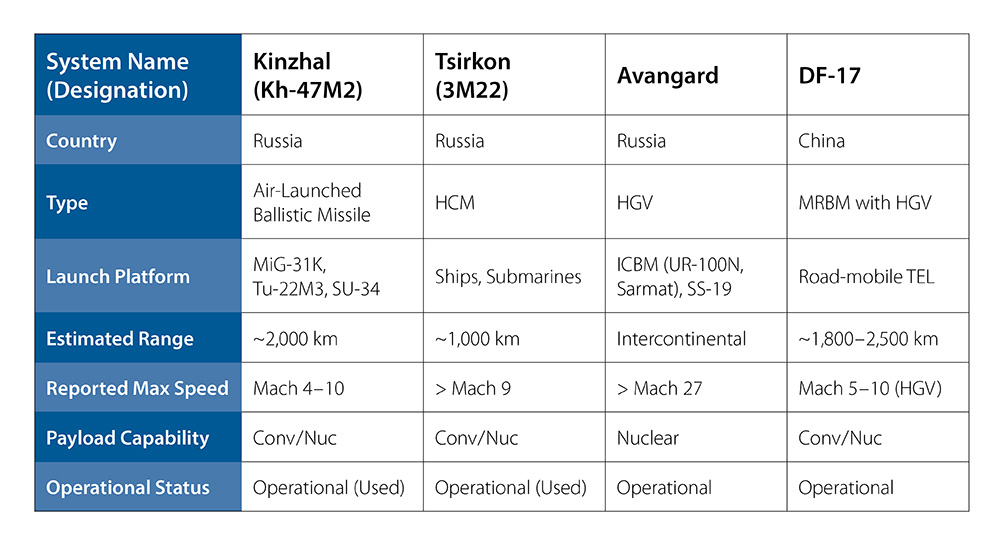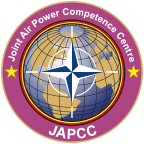Introduction
“The responsiveness, manoeuvrability, and survivability of hypersonic weapons is unmatched by traditional strike capabilities for precision targeting, especially in anti-access/area denial (A2/AD) environments.”1
This stark assessment by Lieutenant General Robert A. Rasch, the US Army’s Rapid Capabilities and Critical Technologies Office director, describes a formidable challenge confronting NATO. Hypersonic weapons (hypersonics) are no longer a distant theoretical concern – they are here now, and potential adversaries, notably Russia and China, have actively developed and fielded these systems. Russia now routinely employs weapons like the Kinzhal and Tsirkon missiles in its ongoing war against Ukraine, providing a grim testament to the immediacy of this threat.2,3,4,5
To better understand the dilemmas created by these weapons, JAPCC is approaching the problem from the perspective of a Surface-Based Air and Missile Defence (SBAMD) operator. Here, at the human level, sitting at the critical juncture of technology, doctrine, and high-stakes decision-making, the new reality is particularly acute: existing SBAMD weapon systems, including the venerable Patriot system, were not designed to search, track, identify, and intercept threats that combine speeds exceeding Mach 5 with atmospheric manoeuvrability. Additionally, policy, doctrine, and training lag hypersonic development, creating gaps not only in defended airspace, but in strategic thinking as well.6,7
This article asserts that hypersonic weapons have reshaped the security landscape fundamentally, requiring a new category of defence integrated across multiple domains. Taking an operator’s viewpoint, the article will characterize the hypersonic threat, detail the specific challenges confronting the SBAMD operator, examine the broader strategic deterrence implications, and provide recommendations for Alliance policy and capability development. The urgency is clear; understanding and addressing the hypersonic challenge, from the operator’s console to the highest levels of strategic planning, is not merely prudent – it is imperative for maintaining credible deterrence and defence in the Euro-Atlantic area.
Example hypersonic missile trajectories and radar coverage. © Council on Geostrategy
Hypersonic Missiles: More than Just Speed
For those unfamiliar with these weapons, understanding their characteristics is an essential first step. NATO defines hypersonic weapons as those which can sustain flight, and manoeuvre within the atmosphere, above Mach 5.8,9 These characteristics allow hypersonic weapons to reach a potential opponent with speeds akin to ballistic missiles, and dynamic and unpredictable flight profiles that have no comparison.10 The weapons primarily come in two variants, each presenting unique challenges:
- Hypersonic Cruise Missiles (HCMs): Like subsonic and supersonic cruise missiles, HCMs fly in a powered, non-ballistic trajectory. They are commonly powered by air-breathing engines, typically scramjets, enabling sustained hypersonic speeds within the atmosphere. One advantage of HCMs is that, due to their continuous propulsion, they can fly at low altitudes to complicate detection. One disadvantage is that they produce a large infrared (IR) signature due to their engines and skin friction heating. Russia’s Tsirkon is a notable example of an HCM.11,12
- Hypersonic Glide Vehicles (HGVs): As its name implies, the HGV is a glide vehicle, typically launched with a large rocket booster which propels it to its desired altitude and speed. Once reaching the speed and altitude (typically 20–60km), the glide body separates and begins an unpowered, manoeuvring profile through the atmosphere, eventually diving towards its final target.13 One advantage of HGVs is their smaller size and signature, while one disadvantage is they must start their profiles at high altitudes, wherein their initial launch may be more prone to detection than HCMs. Russia’s Avangard, and China’s DF-17 are both HGVs.
Challenges: The Operator’s Crucible
While HCMs and HGVs have different design characteristics, they share common challenges for the SBAMD operator. They are hard to find, hard to track, and even harder to intercept. The first challenge, therefore, is simply gathering the facts about the danger of these threats.
Although little information is available on intercept rates, in August 2024, Ukraine’s armed forces claimed to have intercepted 30 out of 117 hypersonic missiles (25%).14 However, these numbers should be used with caution due to many ‘known unknowns’ such as the actual intercept rates of these weapons, Ukraine’s defensive posture and coverage area, and the missile availability of their Patriot/SBAMD weapon systems. Additionally, some data may lead to false conclusions. For instance, Ukraine’s notable success against Russia’s Kinzhal must be put into context. While some reports indicate a high success rate in specific engagements, the Kinzhal is technically a ballistic missile with very limited manoeuvre capability; therefore, it does not represent a complete hypersonic challenge. Where there is reporting on the Tsirkon, a true HCM, the available data reflects a much lower intercept rate.15,16
Table: Lists of current hypersonic systems in Russia and China. © JAPCC
While NATO awaits additional data, it can address other clear challenges, the ‘known knowns’ defying the operator. The unique characteristics of hypersonic weapons create profound difficulties for the operators of current SBAMD systems, spanning the entire engagement sequence. Some of these problems are listed below:
- Detection and tracking difficulties: Current ground-based radar systems face inherent limitations in detecting extremely fast, manoeuvrable targets which are potentially flying at low altitudes utilizing terrain masking. Unlike the high-altitudes of ballistic weapons, hypersonic flight profiles can create line-of-sight constraints which can delay initial detection, further compressing already short engagement timelines.17,18
- Engagement geometry and interceptor limits: Intercepting a hypersonic manoeuvring target is a daunting engineering problem. Interceptors must possess exceptional speed, extreme agility, and sophisticated sensors. Fortunately, the Patriot system has evolved significantly, with PAC-2 Guidance Enhanced Missile-Tactical (GEM-T) missiles optimized for ballistic missiles, and PAC-3 achieving hit-to-kill technology with additional attitude control motors (ACMs) to increase manoeuvrability. Nonetheless, sustained high-G manoeuvres of future hypersonics may exceed the kinematic capabilities of even the best interceptors.19,20
- Decision dilemmas: Having reflected on some of the technical challenges of hypersonics, questions for the operator remain: How do operators defend against this threat? Moreover, they must also ask not just ‘how’, but ‘should we’ attempt an intercept? Is the target (or potential target area) on the defended asset list (DAL)? Is the weapon payload conventional or nuclear? Do SBAMD batteries have suitable interceptors to engage? How many missiles should be shot at one target? Answering these questions is the ‘defender’s crucible’ – with a short engagement timeline, they have mere seconds to verify, identify, prioritize, decide, and engage. The Observe, Orient, Decide, Act (OODA) loop has never been shorter.
Strategic and Deterrence Implications
Recognizing Alliance cohesion and public support as a strategic centre of gravity, NATO adversaries are expected to employ hypersonic weapons to achieve their strategic aims. Russia, for example, has demonstrated a willingness to attack cities to diminish public support for resistance. This directly amplifies the challenges for SBAMD operators, resulting in significant strategic and deterrence implications. Three specific strategic concerns are as follows:
- The unsustainability of comprehensive area defence: Investing solely in defensive systems to intercept hypersonic missiles will not be sufficient to deter an opponent. The defender’s cost burden is too high, both in terms of the number of missiles required and the overall coverage of radars and launchers needed across NATO.21 In short, complete area defence is not an option due to prohibitive financial and logistic costs.
- Point defence vs the ambiguity trap: Point defence is the strategy of electing to defend specific assets and areas within NATO territory. With this strategy, the quiet part is not typically said aloud, but of course this implies deliberately letting weapons get through if they are not a factor to the DAL. Perhaps this is possible with conventional payloads, but the possibility of nuclear payloads may make this an unacceptable gamble. Additionally, manoeuvring hypersonics will create additional ambiguity for defenders attempting to determine the weapons’ final impact points. 22,23
- Erosion of strategic stability: The introduction of hypersonic weapons creates a significant risk of miscalculation and escalation. Due to their ambiguous payloads and unclear trajectories, they blur the threshold between conventional and nuclear warfare. Furthermore, they may lead to ‘first strike temptation’, wherein the perceived ability to penetrate defences encourages both sides to attempt a ‘left of launch’ pre-emptive strike.
Collectively, these dilemmas mean NATO must rethink what a credible deterrence might involve. The next section provides recommendations on what this might look like.
Recommendations
NATO must consider what capabilities it needs to develop to counter the hypersonic weapon threat. Essentially, there are three options: mitigate the threat ‘left of launch’, intercept the threat ‘right of launch’, or accomplish a mix of both. The first option implies pre-emptively averting an enemy attack, potentially at the expense of escalation and miscalculation risks. The second implies a defensive posture which cannot be fully achieved.
Therefore, to be successful, a holistic Integrated Air and Missile Defence (IAMD) strategy should enable both offensive and defensive approaches. Fully interoperable systems must become the baseline, and Command and Control (C2) networks supported by adequate radar and IR sensor coverage must extend across the entirety of NATO airspace. Information dominance and cross-domain teamwork must become the new paradigm.
Furthermore, NATO must mirror hypersonic weapon dilemmas back on our adversaries by adding credible, perhaps the same, offensive capabilities to its inventory. Deep Precision Strike (DPS) capabilities must be reinvigorated. Possessing offensive weapons that can destroy the ‘archers’, not the ‘arrows’, imposes a strategic cost on our adversaries, who must expend significant resources on their own defence. Also, as part of a wider deterrent ‘toolbox’, these weapons create a dilemma for future opponents to deal with.
A robust offensive arsenal could achieve a new deterrence equilibrium that looks like the Mutual Assured Destruction (MAD)24 theory from the Cold War. This principle of deterrence is founded on prohibitive and credible escalation between parties. To achieve such credibility, NATO must do the following:
- Accelerate space-based sensing capabilities: NATO must invest in space-based sensors which complement ground-based surveillance. This capability must include data-sharing agreements, common technical standards, and a robust C2 network to allow continuous tracking of hypersonic threats.
- Develop AI-supported decision tools: To have a reasonable chance of successfully engaging hypersonics, a human operator must be aided by AI. Integration areas include data fusion, automated threat assessment, optimized engagement solutions, and a clear presentation of options to a human decision maker. Human-in-the-loop (HIL) and human-on-the-loop (HOL) paradigms have been thoroughly discussed in NATO, and SBAMD is an ideal use case for the emerging trend of incorporating AI into defence.25,26
- Accelerate NATO hypersonic procurement, testing, wargaming, and doctrine: Working groups within the Alliance must work quickly to develop tactics, techniques, and procedures (TTP), Rules of Engagement (ROE), and C2 procedures to adequately prepare operators, intelligence analysts, and decision authorities for modern air defence realities.27,28
- Field ‘left of launch’ capabilities and enablers: Nations should procure offensive capabilities supporting DPS, including hypersonic weapons, cruise missiles, and one-way attack (OWA) drones. Additionally, this hardware must be supported by robust intelligence gathering, cyber, and electronic warfare (EW) support, and other capabilities that can disrupt enemy launches, or support offensive operations against enemy launch platforms.
- Invest in resilient, interoperable, and distributed C2: NATO C2 underwrites all SBAMD capabilities. It must be seamless, survivable, and redundant. Much has been written on the topic of NATO Air C2, but plans must be put into action within the decade.29
Conclusion
Should we shoot the arrow or the archer? It would be good to be able to shoot them all, and better still to not shoot any in the first place! Therefore, a new multi-domain deterrence approach is necessary. The emergence of operational hypersonic weapons presents a complex and urgent challenge to NATO’s security. As operators on the front lines of NATO’s air and missile defence will agree, these weapons stress current capabilities, compress decision timelines beyond human limits, and introduce dangerous ambiguities that can have strategic consequences.
The Alliance must adapt its defence strategies, considering whether current paradigms are sufficient for modern threats. This assessment must involve payload considerations, political and strategic risk, industrial capacity, and technical capabilities. Addressing this threat requires a comprehensive strategy that goes beyond simply trying to intercept incoming ‘arrows’, and instead focuses on disrupting the ‘archer’ before the shot, intercepting the ‘arrow’ if necessary, and fundamentally strengthening and shortening the air-defence OODA loop.
Doing so requires urgent and focused strategic thinking, collaborative policy development, and targeted investment in critical SBAMD enablers – particularly space-based sensing, AI-augmentation, C2 networks, and robust ‘left of launch’ capabilities. To successfully navigate the hypersonic era, NATO must overcome traditional stovepipes and implement an integrated, multi-domain approach adapted to its new security environment.













